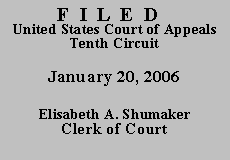

| UNITED STATES OF AMERICA,
Plaintiff-Appellee,
v.
ALFONSO TAFOYA Defendant-Appellant. |
No. 05-2092
(D.C. No. CIV-04-1116) |
Mr. Tafoya pled guilty to a federal drug charge and was sentenced to sixty months of imprisonment. Judgment was entered against him on March 4, 2003, and he did not file a direct appeal challenging any aspect of his conviction or sentence. Nearly nineteen months later on September 30, 2004, Mr. Tafoya filed this habeas action challenging his sentence and claiming his Sixth Amendment rights were violated due to ineffective assistance of counsel. In essence, Mr. Tafoya claimed he received a much longer sentence than his counsel had led him to expect. The district court ordered him to show cause why his petition should not be dismissed as barred by the one year statute of limitations in ADEPA. In response, Mr. Tafoya contended the limitations period should not begin to run until November 23, 2003, when he allegedly learned in a letter from his attorney "that what he had been told prior to his plea and sentencing hearing was different from what actually took place during the sentencing hearing." Rec., doc. 5 at 2. He also asserted that equitable tolling applied to his case because he had diligently pursued his claims by writing three letters to his attorney inquiring as to why he had received a longer sentence than expected. The district court rejected these arguments.
First, the court noted Mr. Tafoya could not rely on the statutory tolling provision in § 2255(4) which directs that the limitations period "shall run from . . . the date on which the facts supporting the claim or claims presented could have been discovered through the exercise of due diligence." 28 U.S.C. § 2255(4). The court reasoned that the November 23, 2003 letter Mr. Tafoya received from his attorney did not disclose to him any facts he did not already know at the time of sentencing, i.e., that he did not receive the sentence he expected.
Second, the district court rejected Mr. Tafoya's argument that he was entitled to equitable tolling. The court pointed out that under controlling Tenth Circuit case law, "[e]quitable tolling is only available when an inmate diligently pursues his claims and demonstrates that the failure to timely file was caused by extraordinary circumstances beyond his control." Rec., doc. 6 at 2 (internal quotations and citations omitted). See also Marsh v. Soares, 223 F.3d 1217, 1220 (10th Cir. 2000). The court reasoned that Mr. Tafoya's three letters to his attorney did not amount to a diligent pursuit of his claims. Nor was Mr. Tafoya able to point to anything that limited his ability to file his action within the required tolling period. The court therefore denied Mr. Tafoya's equitable tolling arguments and dismissed his petition.
The issuance of a COA is jurisdictional, Miller-El v. Cockrell, 537 U.S. 322, 336 (2003), and can issue only "if the applicant has made a substantial showing of the denial of a constitutional right." 28 U.S.C. § 2253(c)(2). "A petitioner satisfies this standard by demonstrating that jurists of reason could disagree with the district court's resolution of his constitutional claims or that jurists could conclude the issues presented are adequate to deserve encouragement to proceed further." Miller-El, 537 U.S. at 327. When a district court has dismissed a habeas petition on procedural grounds, we may only issue a COA when "jurists of reason would find it debatable whether the district court was correct in its procedural ruling." Slack, 529 U.S. at 484. Based on our review of the record on appeal, the district court's order, and Mr. Tafoya's submissions to this court, we do not think jurists of reason would disagree with the district court that Mr. Tafoya neither satisfied the requirements for statutory tolling under § 2255(4), nor presented "rare and exceptional circumstances" warranting equitable tolling of the AEDPA limitations. Gibson v. Klinger, 232 F.3d 799, 808 (10th Cir. 2000).
Accordingly, we DENY Mr. Tafoya's request for a COA and DISMISS the appeal.
ENTERED FOR THE COURT
Stephanie K. Seymour
Circuit Judge
*.After examining appellant's brief and the appellate record, this panel has determined unanimously that oral argument would not materially assist the determination of this appeal. See Fed. R. App. P. 34(a)(2) and 10th Cir. R. 34.1(G). The case is therefore submitted without oral argument. This order and judgment is not binding precedent, except under the doctrines of law of the case, res judicata, or collateral estoppel. The court generally disfavors the citation of orders and judgments; nevertheless, an order and judgment may be cited under the terms and conditions of 10th Cir. R. 36.3.